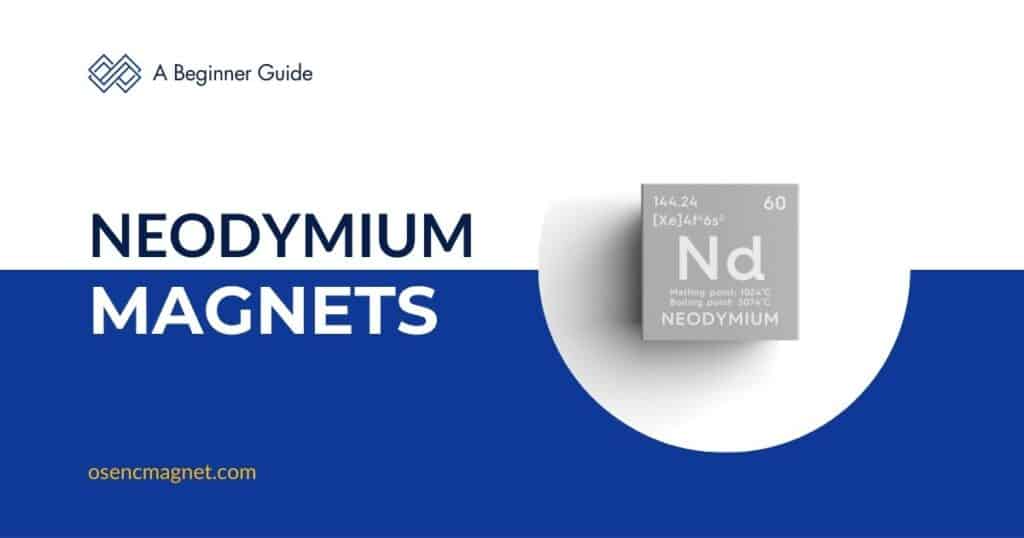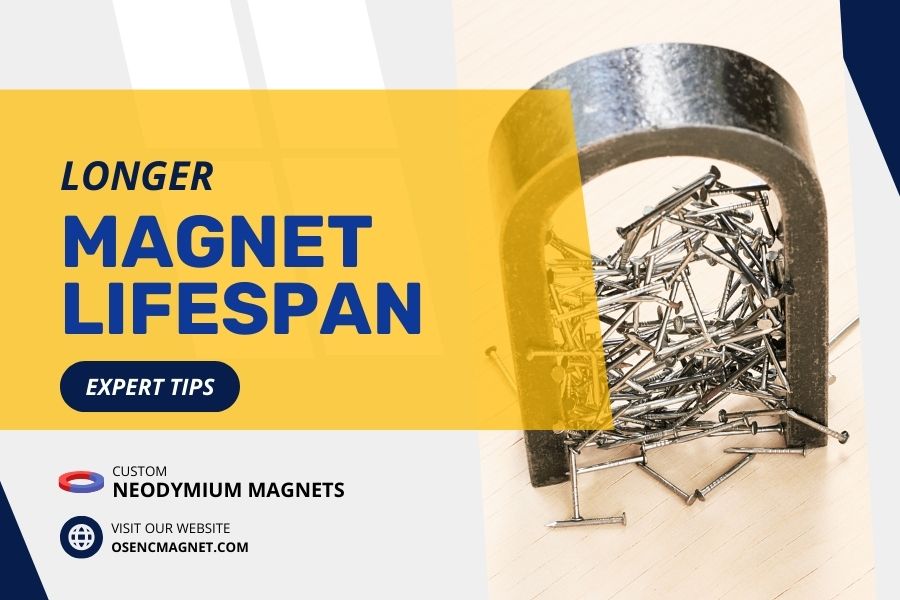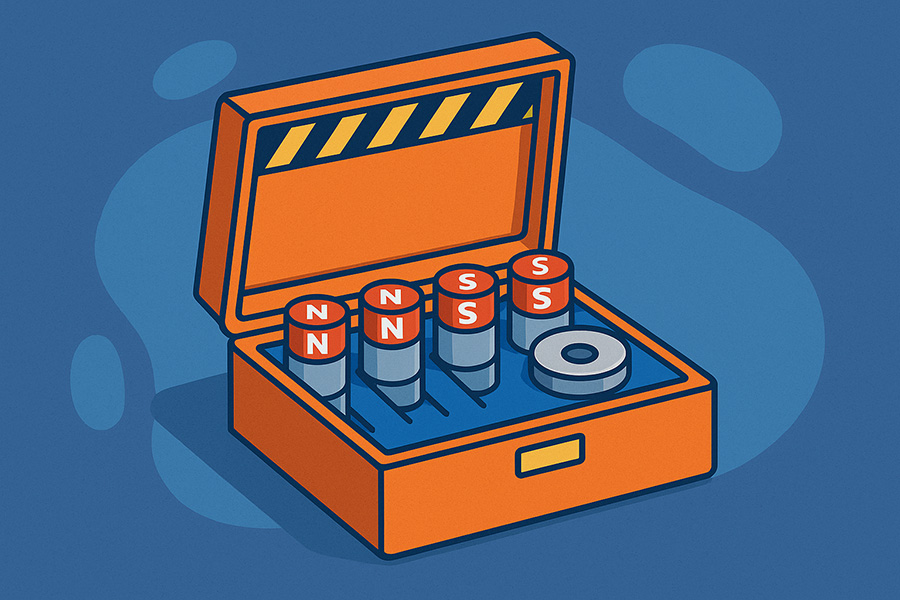Neodymium magnets are the strongest permanent magnets.
This complete guide covers neodymium magnet basics for beginning buyers.
Learn about their composition, grades, coatings, and more.
If you’re new to neodymium magnet buying, start here.
Let’s get started.
Table of Contents
Understanding Neodymium Magnets
What Are Neodymium Magnets?
Neodymium magnets are the strongest permanent magnets you can buy. They’re made from neodymium, iron, and boron (Nd₂Fe₁₄B) and create magnetic fields of 1.0-1.4 teslas—much stronger than regular magnets.
Despite being called “rare earth,” neodymium isn’t actually rare in the earth’s crust. The name comes from the lanthanide group on the periodic table. What makes these magnets special is how much magnetic power they pack into a small size.
Key Advantages of Neodymium Magnets
- Incredible Strength: They can hold up to 1,000 times their weight
- Small Size: They deliver strong magnetic force without taking up much space
- Long-Lasting: They keep over 99% of their strength for decades when treated right
- Versatility: They come in many shapes and sizes for different uses
Common Uses
Neodymium magnets have changed many technologies:
- Consumer Electronics: Speakers, headphones, smartphone parts
- Computer Hardware: Hard drives, magnetic laptop closures
- Automotive: Electric car motors, sensors, door latches
- Renewable Energy: Wind turbine generators, magnetic couplings
- Medical Devices: MRI machines, medical implant connections
- Home and Workshop: Tool holders, cabinet latches, organizing systems

Practical Buying Considerations
Strength in the Real World: Understanding Pull Force
Don’t trust manufacturer pull force ratings completely:
Things that reduce actual performance:
- Gaps between the magnet and target (even tiny ones)
- Rough or dirty surfaces
- Non-ideal materials (thin steel, stainless steel, aluminum)
- Pulling at an angle instead of straight on
- Temperature changes
- Nearby magnetic fields or iron-containing materials
What to expect in real life:
- Perfect contact direct pull: 80-90% of rated strength
- With 0.5mm gap: 50-60% of rated strength
- With 1mm gap: Only 30-40% of rated strength
- Sliding force: Only 20-25% of direct pull force
- Against thin sheet metal: As low as 30% of rated strength
Smart buying advice:
- For important projects, buy magnets 2-3× stronger than you think you need
- Test in real conditions before finalizing your design
- Consider using several smaller magnets instead of one big one for better results
Size and Shape Selection Guide
Disc magnets:
- Most useful and common shape
- Pull force focuses at the center of the flat side
- Usually come in diameters from 3mm to 50mm
- Best for: General attachment, crafts, simple holding tasks
Block/rectangular magnets:
- Give maximum strength for their size
- Pull force spreads evenly across the surface
- Can be positioned for different magnetic field patterns
- Best for: Sliding applications, stronger holding, magnetic locks
Ring/cylinder magnets:
- Field concentrates at the edges with empty center
- Self-center when paired with another magnet or steel rod
- Can stack to boost strength
- Best for: Alignment needs, rotating assemblies, sensors
Countersunk/mounting magnets:
- Have a depression or hole for a screw
- Allow secure attachment
- Come in various shapes (usually disc or block)
- Best for: Permanent mounting, high-security uses
Sphere magnets:
- Equal magnetic field in all directions
- Roll and pivot while staying connected
- Often used in creative projects and toys
- Best for: Kinetic sculptures, fidget toys, educational demos
Choosing the right size:
- Diameter/length: Mainly determines overall strength
- Thickness: Determines how deep the field penetrates
- Doubling the diameter makes it four times stronger
- Doubling the thickness does NOT double the surface strength (might only add 30-40%)
Coatings: Essential for Longevity
Without protection, neodymium magnets break down quickly:
Common coating types:
- Nickel (Ni): Standard silver coating, good indoors
- Nickel-Copper-Nickel (Ni-Cu-Ni): Triple-layer protection, tougher
- Zinc: Better against corrosion than standard nickel, duller look
- Gold: Premium appearance with excellent corrosion resistance
- Epoxy: Complete coverage in various colors, best for harsh conditions
- Parylene: Thin, even plastic coating for special uses
- Rubber: Soft coating that adds grip and prevents scratches
Warning signs of coating failure:
- Flaking or chipping of the surface
- White powder forming (early oxidation)
- Brownish stains (advanced rusting)
- Once oxidation starts, it spreads fast and ruins the magnet
Coating choice by environment:
- Indoor, climate-controlled: Standard nickel works fine
- Bathroom/kitchen: Ni-Cu-Ni or epoxy recommended
- Outdoor or humid areas: Epoxy coating is a must
- Marine environments: Multiple layer protection plus secondary case
How to fix damaged coatings:
- Clean and fully dry the exposed area
- Apply clear nail polish for a quick temporary fix
- Use clear epoxy for a longer-lasting solution
- Store in a dry place with desiccant if possible
Technical Specifications Explained
Grades Explained: Beyond Just N35 vs N52
The grade system directly affects price and performance:
- The number after “N” shows the maximum energy product in MGOe (megagauss-oersteds)
- Common grades range from N35 to N52
- Each step up means about 5-10% more magnetic strength
- Higher grades contain more neodymium and less iron
- Higher grades usually cost more for the same size
Real-world performance differences:
- An N52 magnet is about 50% stronger than an N35 magnet of the same size
- Higher grades don’t always give better value — N42 magnets often hit the sweet spot for price/performance
- The strongest theoretical grade is around N64, but you rarely find commercial magnets above N55
Practical grade selection guide:
For hobby projects: N35-N42 offers good value
For critical applications: N45-N52 when you need maximum strength
For best all-around performance: N42 balances strength and cost effectively
Temperature Ratings: Critical for Success
Temperature limits are often overlooked when picking magnets:
Standard temperature ratings:
- N: Standard (80°C/176°F) — for indoor, climate-controlled spaces
- M: Medium (100°C/212°F) — for slightly warmer uses
- H: High (120°C/248°F) — for moderately hot environments
- SH: Super High (150°C/302°F) — for hot environments
- UH: Ultra High (180°C/356°F) — for very hot environments
- EH: Extremely High (200°C/392°F) — for extreme heat applications
- TH: Thermal High (220°C/428°F) — highest available temperature rating
What happens when magnets get too hot:
- Going above the temperature rating causes permanent and irreversible loss of magnetic strength
- Even brief overheating can degrade performance
- Once demagnetized by heat, the magnet can’t be restored to its original strength
- Neodymium magnets have a Curie temperature of around 310-400°C, where they lose all magnetism
Temperature rating selection guide:
- For home/office use: Standard N-rating is enough
- For use in vehicles: Choose H-rating minimum due to potential heat buildup
- For kitchen or near heating elements: SH-rating recommended
- For industrial equipment: UH or EH-rating typically needed
- For specialized high-temperature applications: Consider samarium-cobalt instead
Comparing Magnet Types: Making the Right Choice
Understanding how neodymium magnets stack up against other options helps you make smarter buying decisions:
Ferrite (Ceramic) Magnets:
- 5-10 times weaker than neodymium
- Very cheap (often 1/10 the cost)
- Great corrosion resistance (no coating needed)
- Good heat resistance (up to 250°C)
- Found in refrigerator magnets and cheap toys
- Best for: Low-cost projects where size isn’t important
Alnico Magnets:
- Medium strength (stronger than ferrite but weaker than neodymium)
- Excellent temperature stability (up to 500°C without losing magnetism)
- Poor resistance to demagnetization (need “keepers” when stored)
- More expensive than ferrite, but cheaper than rare-earth magnets
- Found in guitar pickups, older speakers, and some measuring tools
- Best for: High-temperature applications and audio equipment
Samarium-Cobalt Magnets:
- Nearly as strong as neodymium (about 75-85% the strength)
- Excellent corrosion resistance without coating
- Superior high-temperature performance (up to 300°C)
- Much more expensive due to cobalt content
- Used in specialized high-heat motors and military applications
- Best for: High-temperature or corrosive environments
When to choose which type:
- Choose neodymium when you need maximum strength in the smallest possible package
- Consider samarium-cobalt when your project involves high temperatures
- Use alnico when you need good performance at extreme temperatures and aren’t worried about demagnetization
- Select ferrite when cost is critical and you can use a larger size
Manufacturing Processes and Their Impact
Understanding how neodymium magnets are made helps you pick the right magnet for your needs:
Sintered vs. Bonded Magnets
Sintered magnets (most common):
- Raw materials are melted together and cast into ingots
- Ingots are ground into fine powder
- Powder is pressed in a magnetic field to align particles
- The pressed shape is sintered (heated without fully melting) to fuse particles
- The resulting block is cut, ground, or machined to final shape
- Surface is coated to prevent corrosion
- Final magnetization happens in a powerful electromagnetic field
Bonded magnets:
- NdFeB powder is mixed with polymer binder (epoxy or nylon)
- Mixture is compression-molded or injection-molded into final shape
- Sometimes magnetized during molding to align particles
- Curing process hardens the composite material
- Little or no additional processing needed
Practical differences for buyers:
- Sintered magnets: Maximum strength, more brittle, need coating
- Bonded magnets: 30-60% weaker, more flexible, complex shapes possible
- Bonded magnets often cost more despite being weaker
- For maximum strength, always choose sintered magnets
- For unusual shapes or durability, consider bonded magnets
Essential Safety Information
Neodymium magnets pose unique risks that differ from ordinary magnets:
Physical Hazards
- Pinch injuries: Strong magnets can cause severe pinching that leads to blisters or bruising
- Shattering risk: They can break into sharp fragments if they snap together or if dropped
- Impact injuries: Large magnets accelerating together can hit with surprising force
Electronic and Medical Concerns
- Pacemaker interference: Keep at least 6 inches (15cm) away from pacemakers and implanted medical devices
- Electronic damage: Can erase magnetic media, damage hard drives, and interfere with electronics
- Compass deviation: Will affect compass readings and navigation equipment
Ingestion Dangers
- Extremely serious if swallowed: Multiple magnets can attract through intestinal walls, causing perforation
- Medical emergency: Requires immediate medical attention if ingested
- Keep away from children: Should be treated as a serious hazard for young children
Safe Handling Techniques
- Wear eye protection when handling larger magnets
- Use gloves to improve grip and prevent pinching
- Keep a wooden dowel or plastic spacer handy to separate stuck magnets
- Never place fingers between magnets that are coming together
- Slide magnets apart sideways rather than pulling directly
- Store with keepers or in original packaging with proper spacing
Common Buyer Mistakes to Avoid
- Underestimating strength needs: Always test before committing to a design
- Overestimating coating durability: Even nickel coatings can chip or scratch
- Ignoring temperature limits: Heat is the #1 killer of neodymium magnets
- Not accounting for material thickness: Target material must be thick enough (minimum 3mm steel for full strength)
- Choosing the wrong shape: Consider how the magnet will align in your application
- Forgetting about spacing: Any air gap dramatically reduces pull force
- Not considering repulsion force: Pushing magnets apart requires more force than pulling them apart
- Overlooking safety concerns: Strong magnets can cause serious injuries if handled carelessly
Buying Quality Neodymium Magnets
What to Look for in a Vendor
- Clear specification of grade (N42, etc.) and coating type
- Detailed dimensions with tolerances listed (±0.1mm or better)
- Pull force measurements in both pounds and kilograms
- Proper packaging with magnetic keepers
- Satisfaction guarantees and return policies
- Educational content about proper usage
- Customer support that can answer technical questions
Warning Signs of Poor-Quality Magnets
- Vague descriptions without specific grade information
- Unusually low prices compared to competitors
- No specific coating information
- Poor packaging that allows magnets to snap together
- No safety warnings or handling instructions
- Missing or inconsistent specifications
Testing Your Magnets
When you receive your magnets, check:
- Dimensions match specifications (use calipers if possible)
- Coating is uniform without bubbles, chips, or discoloration
- Pull force seems appropriate (rough testing with known weights)
- Magnets are properly magnetized (field should be consistent)
FAQ for First-Time Buyers
Q: How do I safely separate strong magnets that are stuck together?
A: Slide them apart sideways rather than pulling directly. Place them on the edge of a table and push the top magnet sideways while holding the bottom one. For very strong magnets, wear gloves and use a wooden wedge.
Q: What’s the best way to attach magnets to non-metal surfaces?
A: For permanent mounting, use epoxy adhesive after roughening the magnet’s surface slightly with sandpaper. For temporary mounting, use industrial-strength double-sided tape. Always clean both surfaces thoroughly before attaching.
Q: Will these magnets lose strength over time?
A: Under normal conditions, neodymium magnets lose less than 1% of their strength per decade. Heat, radiation, strong opposing magnetic fields, or physical damage are the main causes of demagnetization.
Q: How do I calculate what size magnet I need?
A: Take the weight you need to support, multiply by 10 for a safety factor, then find a magnet with that pull force rating. Remember that real-world conditions will reduce the actual pull force significantly.
Q: Can I cut or drill holes in these magnets?
A: No. They will shatter, and the dust is highly flammable. Always buy the exact size and shape needed. Pre-drilled or countersunk options are available for mounting.
Q: Are cheaper magnets from marketplace sellers worth buying?
A: Generally no. Lower-priced magnets often have inconsistent strength, thinner coatings, and may use recycled materials that don’t meet stated specifications. The small savings rarely justify the performance inconsistency.
Q: How close can I place these magnets to electronics?
A: Keep powerful magnets at least 6 inches from hard drives, credit cards, and pacemakers. Modern solid-state electronics (phones, tablets) are less susceptible but still keep magnets 2-3 inches away to be safe.
Q: Can I use these magnets outdoors?
A: Only with proper protection. For outdoor use, choose magnets with epoxy or multiple-layer coatings, and consider placing them in a weather-resistant enclosure. Check them periodically for signs of corrosion.
Final Thoughts
These incredible neodymium magnets can transform your projects when chosen wisely.
Their remarkable strength makes them perfect for countless uses – from simple home organization to complex industrial applications.
Need custom neodymium magnets?
Osenc Magnet people are here to help!



